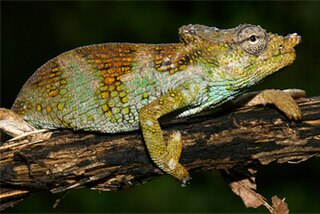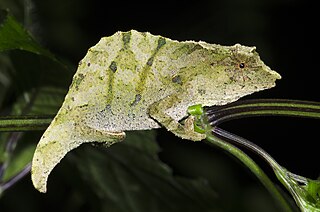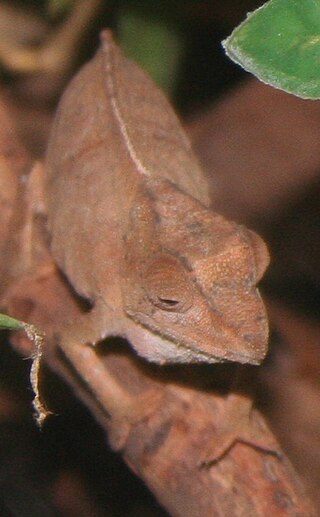
Rhampholeon is a genus of small chameleons, commonly known as pygmy chameleons or African leaf chameleons, found in East Africa and Central Africa. They are found in forests, woodlands, thickets, and savanna, and most species are restricted to highlands. They are brown, grey, or green, and typically seen at low levels in bushes, or on the ground among grasses or leaf litter.

Fischer's chameleon, also known commonly as the Nguru blade-horned chameleon and the Nguru two-horned chameleon, is a species of chameleon, a lizard in the family Chamaeleonidae. The species is endemic to Tanzania.

The spectral pygmy chameleon, also known as western pygmy chameleon or Cameroon stumptail chameleon, is one of the so-called "dwarf" or "leaf" chameleons, from mainland Africa.

Kinyongia vanheygeni, the Poroto single-horned chameleon or Van Heygen's chameleon, is a species of chameleon, a lizard in the family Chamaeleonidae.
Kinyongia carpenteri, commonly called Carpenter's chameleon or the helmeted chameleon, is a species of chameleon, a lizard in the family Chamaeleonidae. The species is native to central Africa.
Rieppeleon brachyurus, known commonly as the zomba pygmy chameleon, is a species of chameleon, a lizard in the family Chamaeleonidae. The species is endemic to eastern and southeastern Africa.

Rieppeleon kerstenii is species of chameleon, a lizard in the family Chamaeleonidae. The species is endemic to East Africa.
Kinyongia adolfifriderici is a species of chameleon, a lizard in the family Chamaeleonidae. The species is native to central Africa and east Africa.
Kinyongia asheorum, also known commonly as the Mount Nyiro bearded chameleon, is a species of lizard in the family Chamaeleonidae. The species is endemic to Kenya. Only four specimens are known.

Kinyongia uthmoelleri, known commonly as the Hanang hornless chameleon, Müller's leaf chameleon, and Uthmöller's chameleon, is species of lizard in the family Chamaeleonidae. The species is endemic to Tanzania.

Kinyongia vosseleri, also known commonly as the Usambara two-horned chameleon and Vosseler's blade-horned chameleon, is an endangered species of lizard in the family Chamaeleonidae. The species is endemic to Tanzania.
Rhampholeon chapmanorum, also known commonly as Chapmans' pygmy chameleon, is a species of terrestrial pygmy chameleon, a lizard in the family Chamaeleonidae. The species is endemic to forest fragments in the Natundu Hills, Malawi. It was described as a species new to science by Colin R. Tilbury in 1992, from a patch of lowland seasonal rainforest in the Matandwe Forest Reserve.

Rhampholeon acuminatus, the Nguru pygmy chameleon, is a species of chameleons endemic to Tanzania.
Rhampholeon boulengeri, also known commonly as Boulenger’s pygmy chameleon, is a species of lizard in the family Chamaeleonidae. The species is native to eastern Africa.

Rhampholeon moyeri, also known commonly as Moyer's pygmy chameleon or Udzungwa pygmy chameleon, endemic to Tanzania.
Rhampholeon nchisiensis, the South African stumptail chameleon or Nchisi pygmy chameleon, is a species of chameleon found in Malawi and Tanzania.

Rhampholeon temporalis, the Usambara stumptail chameleon or East Usambara pygmy chameleon, is a species of chameleon found in Tanzania.

Rhampholeon viridis, the green pygmy chameleon, is a species of chameleons endemic to Tanzania.

Trioceros ellioti, also known commonly as Elliot's chameleon, Elliot's groove-throated chameleon, and the montane side-striped chameleon, is a species of lizard in the family Chamaeleonidae. The species is indigenous to Africa.
Trioceros fuelleborni, also known commonly as the flapjack chameleon, the Ngosi Volcano chameleon, and the Poroto three-horned chameleon, is a species of lizard in the family Chamaeleonidae. The species is endemic to Tanzania.














